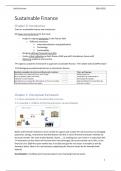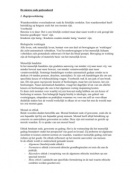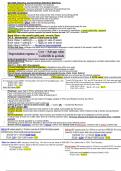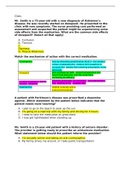Sofie De Korte 2024-2025
Sustainable Finance
Chapter 0: Introduction
Track on sustainable finance and investment:
My hopes and excitement for this track:
- Insight in ongoing evolutions in the finance field
o Different evolutions
▪ Internationalization and globalization
▪ Technology
▪ Sustainability
- Bringing sufficient financial hard skills
- Foster critical reflection on both finance AND yourself (=disciplinary future self)
- Balancing academia and practice
→ A rigorous academic framework to approach sustainable finance: “let’s define what SUSFIN means”
→ Challenging assumptions/practices in mainstream finance
Chapter 1: Conceptual framework
1.1 Some examples of unsustainable practices
1.1.1 Example 1: Inflation of the financial sector via securitization
Banks and financial institutions were created to support and sustain the real economy, by managing
payments, savings, investments and distribution. But this is not all financial institution markets do:
the asset market. The asset market (bonds, shares, …) is anything you can invest in or speculate with
→ investment so that value will increase over time (leverage). But asset markets carry risks, in the
financial crisis 2009 the asset market was in trouble and got the real sector in trouble as well by
slowing it down. Now is the real economy supporting the financial sector by for example bank
bailouts.
Securitization = building new financial products out of existing financial assets
1
,Sofie De Korte 2024-2025
- Securitization created new markets which inflated the financial sector
- 1980 real and financial economy were equal in size
- Now financial economy > real economy
- Financial market has grown tremendously → also the securities output increased by a huge
amount
Blue: market value of all shares outstanding
Grey: fixed income securities (shares, bonds being
sold)
Around 1980s: size of equity & debt outstanding was
roughly the size of the real economy (GDP created in
real economy), it has grown ever since
Stock market capitalization as % of GDP (Buffet Indicator)
This is all about: Stock markets/ shares as
percentage of GDP
1980s: 50%, so total outstanding market value of all
shares in US econmy was arournd half of US GDP
Now: around %
S&P500 versus real economy-indicators
Showing covid shock
Blue line (stock market) is much more
forward looking, especially in fin crisis, it
disconnects from the real econ indicators
2
,Sofie De Korte 2024-2025
Assets-based security: ABS
- Security backed by a pool of assets
- You create new financial products out of already existing financial assets = securitization
- CDO’s and CDS’s are very unstable markets
ABS: banks have all kind of assets,
difficult to match with the short
term liabilities so they pool their
assets (mortages vb) repackage
into marketable securities (that
they can sell on the market) =>
off balance sheet
- Pooling assets
o Bank owns assets (ex. mortgages) which are very safe but illiquid because the slow
pay back
o Collateral: mortgage
o Bank want more liquid assets, out of the pool of assets new securities are created
and sold to different investors → bank does not do this herself: other financial
institution
- De-linking
o Banks work with other institutions that sell different securities to different investors
o Special purpose entity: SPE
- Trenching
o The other financial institutions slice different financial products out of this pool of
assets
o Senior class AAA: less return, low risk
o Equity (unrated): high return, high risk → when people don’t pay back their
mortgages the risky securities will be impacted first
Collateralized debt obligation: CDO
Process does not stop there → the process of pooling asset backed securities and further trench
them into different securities
- CDO = repackaging of different ABS
- Senior class CDO AAA: safe
- Junk class CDO unrated: risky
- Financial crisis: these securities were rated but
appeared to be very unstable
3
, Sofie De Korte 2024-2025
Credit default swap: CDS
- Financial agent owns an asset (bond, CDO, …) but does not want to take the risk of default
(= risk of going bankrupt),because if the issuer defaults you will get nothing → on CDS
market you can find another agent that is willing to take the risk: default protection seller
which will receive periodical fees from the default protection buyer → its like an insurance
contract → when the asset would default the seller will pay the nominal amount of the
buyer
- CDS are created for hedging purposes → hedge the risk away → but the market also
attracted many speculators because you don’t even need to own the asset to engage in the
CDS contracts → they bedded on the default of assets
We see a big increase in CDO’s and
CDS’s → very popular form of
securitization but very unstable
2007: all major banks owned them, when people in US stopped paying mortgage, they turned out to be
useless, so banks has to acknowledge the losses but could not so governements had to step in =>
raising taxes
So CDO and CDS had outgrown the real economy
4
Sustainable Finance
Chapter 0: Introduction
Track on sustainable finance and investment:
My hopes and excitement for this track:
- Insight in ongoing evolutions in the finance field
o Different evolutions
▪ Internationalization and globalization
▪ Technology
▪ Sustainability
- Bringing sufficient financial hard skills
- Foster critical reflection on both finance AND yourself (=disciplinary future self)
- Balancing academia and practice
→ A rigorous academic framework to approach sustainable finance: “let’s define what SUSFIN means”
→ Challenging assumptions/practices in mainstream finance
Chapter 1: Conceptual framework
1.1 Some examples of unsustainable practices
1.1.1 Example 1: Inflation of the financial sector via securitization
Banks and financial institutions were created to support and sustain the real economy, by managing
payments, savings, investments and distribution. But this is not all financial institution markets do:
the asset market. The asset market (bonds, shares, …) is anything you can invest in or speculate with
→ investment so that value will increase over time (leverage). But asset markets carry risks, in the
financial crisis 2009 the asset market was in trouble and got the real sector in trouble as well by
slowing it down. Now is the real economy supporting the financial sector by for example bank
bailouts.
Securitization = building new financial products out of existing financial assets
1
,Sofie De Korte 2024-2025
- Securitization created new markets which inflated the financial sector
- 1980 real and financial economy were equal in size
- Now financial economy > real economy
- Financial market has grown tremendously → also the securities output increased by a huge
amount
Blue: market value of all shares outstanding
Grey: fixed income securities (shares, bonds being
sold)
Around 1980s: size of equity & debt outstanding was
roughly the size of the real economy (GDP created in
real economy), it has grown ever since
Stock market capitalization as % of GDP (Buffet Indicator)
This is all about: Stock markets/ shares as
percentage of GDP
1980s: 50%, so total outstanding market value of all
shares in US econmy was arournd half of US GDP
Now: around %
S&P500 versus real economy-indicators
Showing covid shock
Blue line (stock market) is much more
forward looking, especially in fin crisis, it
disconnects from the real econ indicators
2
,Sofie De Korte 2024-2025
Assets-based security: ABS
- Security backed by a pool of assets
- You create new financial products out of already existing financial assets = securitization
- CDO’s and CDS’s are very unstable markets
ABS: banks have all kind of assets,
difficult to match with the short
term liabilities so they pool their
assets (mortages vb) repackage
into marketable securities (that
they can sell on the market) =>
off balance sheet
- Pooling assets
o Bank owns assets (ex. mortgages) which are very safe but illiquid because the slow
pay back
o Collateral: mortgage
o Bank want more liquid assets, out of the pool of assets new securities are created
and sold to different investors → bank does not do this herself: other financial
institution
- De-linking
o Banks work with other institutions that sell different securities to different investors
o Special purpose entity: SPE
- Trenching
o The other financial institutions slice different financial products out of this pool of
assets
o Senior class AAA: less return, low risk
o Equity (unrated): high return, high risk → when people don’t pay back their
mortgages the risky securities will be impacted first
Collateralized debt obligation: CDO
Process does not stop there → the process of pooling asset backed securities and further trench
them into different securities
- CDO = repackaging of different ABS
- Senior class CDO AAA: safe
- Junk class CDO unrated: risky
- Financial crisis: these securities were rated but
appeared to be very unstable
3
, Sofie De Korte 2024-2025
Credit default swap: CDS
- Financial agent owns an asset (bond, CDO, …) but does not want to take the risk of default
(= risk of going bankrupt),because if the issuer defaults you will get nothing → on CDS
market you can find another agent that is willing to take the risk: default protection seller
which will receive periodical fees from the default protection buyer → its like an insurance
contract → when the asset would default the seller will pay the nominal amount of the
buyer
- CDS are created for hedging purposes → hedge the risk away → but the market also
attracted many speculators because you don’t even need to own the asset to engage in the
CDS contracts → they bedded on the default of assets
We see a big increase in CDO’s and
CDS’s → very popular form of
securitization but very unstable
2007: all major banks owned them, when people in US stopped paying mortgage, they turned out to be
useless, so banks has to acknowledge the losses but could not so governements had to step in =>
raising taxes
So CDO and CDS had outgrown the real economy
4











